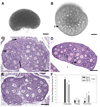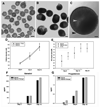A novel two-step strategy for in vitro culture of early-stage ovarian follicles in the mouse
- PMID: 20004373
- PMCID: PMC2873094
- DOI: 10.1016/j.fertnstert.2009.10.027
A novel two-step strategy for in vitro culture of early-stage ovarian follicles in the mouse
Abstract
Objective: To develop an in vitro strategy to support the growth of early-stage follicles and produce mature oocytes competent for fertilization.
Design: Whole ovaries from 8-day-old mice were cultured for 4 days, and then secondary follicles were isolated and cultured for 12 days in a three-dimensional alginate or fibrin-alginate (FA) hydrogel matrix.
Setting: University-affiliated laboratory.
Animals: Mice.
Intervention(s): None.
Main outcome measures: Histologic evaluation of follicle development, steroid hormone production, and rates of oocyte maturation, oocyte fertilization, and embryo formation.
Result(s): Culture of 8-day-old mouse ovaries for 4 days resulted in transition of the follicle population from primordial and primary follicles to secondary follicles, similar to that seen in a 12-day-old ovary. Isolated secondary follicles cultured for 12 days showed larger increases in oocyte diameter and more frequent antrum formation and theca cell differentiation in the FA-hydrogel matrix compared with the alginate matrix. Steroid hormone secretion patterns were consistent with the changes in follicle morphology and cell differentiation observed in the cultured follicles. Compared with oocytes from alginate follicle cultures, a greater number of oocytes retrieved from the FA-based follicle cultures progressed to metaphase I, reached metaphase II, and could be fertilized and cleaved to two-cell embryos. The organ culture plus FA-hydrogel follicle culture strategy produced a very high rate of oocyte progression to metaphase II (88 +/- 8.7% [mean +/- SEM]) and formation of two-cell embryos (54 +/- 4%).
Conclusion(s): A strategy combining whole ovary culture of early-stage follicles and subsequent FA hydrogel in vitro follicle culture produced a high percentage of oocytes competent for fertilization; this might provide new options for fertility preservation in women and prepubertal girls facing fertility-threatening diseases or treatments.
Copyright 2010 American Society for Reproductive Medicine. Published by Elsevier Inc. All rights reserved.
Figures



Similar articles
-
Fibrin promotes development and function of macaque primary follicles during encapsulated three-dimensional culture.Hum Reprod. 2013 Aug;28(8):2187-200. doi: 10.1093/humrep/det093. Epub 2013 Apr 21. Hum Reprod. 2013. PMID: 23608357 Free PMC article.
-
Matrix-free 3D culture supports human follicular development from the unilaminar to the antral stage in vitro yielding morphologically normal metaphase II oocytes.Hum Reprod. 2021 Apr 20;36(5):1326-1338. doi: 10.1093/humrep/deab003. Hum Reprod. 2021. PMID: 33681988 Free PMC article.
-
Fibrin-alginate hydrogel supports steroidogenesis, in vitro maturation of oocytes and parthenotes production from caprine preantral follicles cultured in group.Reprod Domest Anim. 2016 Dec;51(6):997-1009. doi: 10.1111/rda.12779. Epub 2016 Sep 21. Reprod Domest Anim. 2016. PMID: 27650787
-
Three-dimensional systems for in vitro follicular culture: overview of alginate-based matrices.Reprod Fertil Dev. 2014 Aug;26(7):915-30. doi: 10.1071/RD12401. Reprod Fertil Dev. 2014. PMID: 23866836 Free PMC article. Review.
-
In vitro development of ovarian follicles.Semin Reprod Med. 2011 Jan;29(1):15-23. doi: 10.1055/s-0030-1268700. Epub 2011 Jan 4. Semin Reprod Med. 2011. PMID: 21207331 Review.
Cited by
-
Ontogeny of the ovary in polycystic ovary syndrome.Fertil Steril. 2013 Jul;100(1):23-38. doi: 10.1016/j.fertnstert.2013.02.011. Epub 2013 Mar 6. Fertil Steril. 2013. PMID: 23472949 Free PMC article. Review.
-
Effects of Androgen Excess-Related Metabolic Disturbances on Granulosa Cell Function and Follicular Development.Front Endocrinol (Lausanne). 2022 Feb 14;13:815968. doi: 10.3389/fendo.2022.815968. eCollection 2022. Front Endocrinol (Lausanne). 2022. PMID: 35237237 Free PMC article.
-
Growth and differentiation factor 9 promotes oocyte growth at the primary but not the early secondary stage in three-dimensional follicle culture.J Assist Reprod Genet. 2016 Aug;33(8):1067-77. doi: 10.1007/s10815-016-0719-z. Epub 2016 May 7. J Assist Reprod Genet. 2016. PMID: 27155601 Free PMC article.
-
A Novel Three-Dimensional Follicle Culture System Decreases Oxidative Stress and Promotes the Prolonged Culture of Human Granulosa Cells.ACS Appl Mater Interfaces. 2023 Mar 29;15(12):15084-15095. doi: 10.1021/acsami.2c18734. Epub 2023 Mar 16. ACS Appl Mater Interfaces. 2023. PMID: 36926803 Free PMC article.
-
In vitro growth of the ovarian follicle: taking stock of advances in research.JBRA Assist Reprod. 2022 Aug 4;26(3):508-521. doi: 10.5935/1518-0557.20210076. JBRA Assist Reprod. 2022. PMID: 34995044 Free PMC article. Review.
References
-
- Von Wolff M, Donnez J, Hovatta O, Keros V, Maltaris T, Montag M, et al. Cryopreservation and autotransplantation of human ovarian tissue prior to cytotoxic therapy--a technique in its infancy but already successful in fertility preservation. Eur J Cancer. 2009;45:1547–1553. - PubMed
-
- O’Brien MJ, Pendola JK, Eppig JJ. A revised protocol for in vitro development of mouse oocytes from primordial follicles dramatically improves their developmental competence. Biol Reprod. 2003;68:1682–1686. - PubMed
-
- Wandji SA, Srsen V, Voss AK, Eppig JJ, Fortune JE. Initiation in vitro of growth of bovine primordial follicles. Biol Reprod. 1996;55:942–948. - PubMed
-
- Wandji SA, Srsen V, Nathanielsz PW, Eppig JJ, Fortune JE. Initiation of growth of baboon primordial follicles in vitro. Hum Reprod. 1997;12:1993–2001. - PubMed
Publication types
MeSH terms
Substances
Grants and funding
LinkOut - more resources
Full Text Sources
Other Literature Sources

